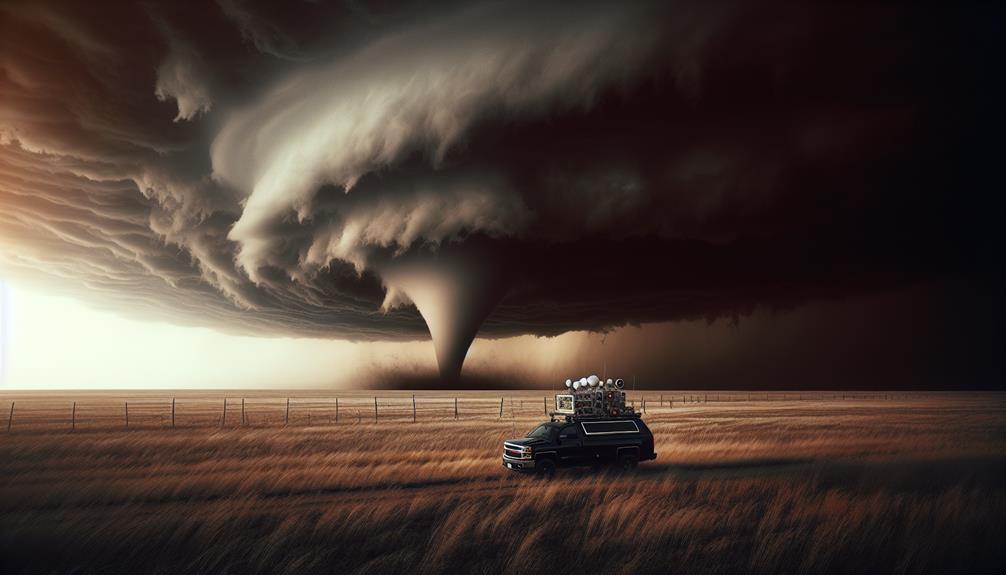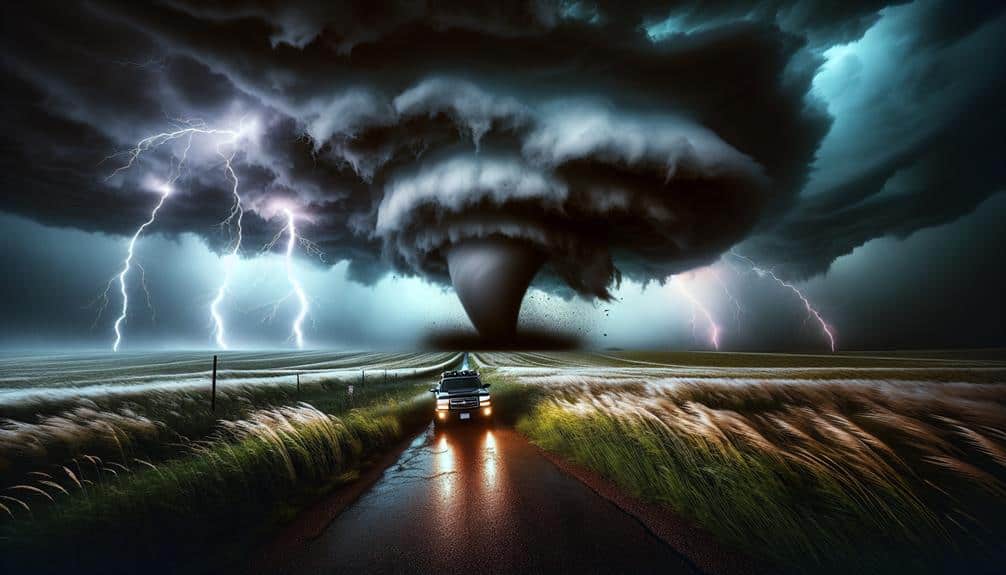Capturing storms requires precise methods and reliable equipment. We begin by adjusting our camera to manual mode, setting a low ISO, and a small aperture. A weather-resistant tripod is crucial. Safety is key; we communicate our plans to someone and wear protective gear. For engaging footage, we focus on shot composition, utilize natural lighting, and incorporate high-quality microphones with wind shields. Data collection is enhanced by drones and satellite imagery, allowing for a multi-faceted analysis. In post-production, we ensure precise color correction, crisp audio, and consistent methods. Our extensive guide offers deeper insights into mastering storm capture.
Key Points
- Use manual camera settings with low ISO and small aperture for high-quality storm images.
- Ensure safety by wearing protective gear and monitoring weather updates continuously.
- Gather comprehensive data using satellites, drones, and real-time transmission for accurate analysis.
- Enhance footage with color correction and sound editing for clear representation of storm characteristics.
Equipment Essentials
To successfully capture storms, we need to equip ourselves with reliable, high-quality instruments. First, let's focus on camera settings. We should make sure our cameras are set to manual mode, allowing us to control shutter speed, aperture, and ISO. A lower ISO (100-400) minimizes noise, while a small aperture (f/8-f/16) enhances depth of field. Shutter speed varies depending on the storm's intensity; longer exposures capture lightning trails, while shorter ones freeze fast-moving elements.
Tripod stability is essential. A sturdy, weather-resistant tripod prevents camera shake, especially during long exposures. We should prioritize models with adjustable legs and a robust ball head to maintain composure on uneven terrain.
Weatherproof gear is non-negotiable. Our cameras and lenses must withstand harsh elements. Look for sealed bodies and lenses to prevent water and dust ingress. A rain cover adds an extra layer of protection.
When it comes to lens selection, versatility is key. A wide-angle lens (16-35mm) captures expansive storm vistas, while a telephoto lens (70-200mm) zooms in on specific features like lightning or cloud formations. By combining these elements, we're prepared to document nature's fury with precision and clarity.
Safety Protocols
Ensuring our safety during storm photography demands adherence to strict protocols and constant watchfulness. We must prioritize our well-being, employing emergency procedures and protective gear to mitigate risks. Before heading out, we should always inform someone about our location and expected return time. This guarantees that help can be dispatched if we encounter unforeseen dangers.
Wearing appropriate protective gear is non-negotiable. This includes insulated, waterproof clothing to shield us from harsh weather and potential hypothermia. Helmets and sturdy boots provide additional safety against falling debris and slippery conditions. Additionally, carrying a well-stocked first-aid kit is vital for addressing minor injuries on the spot.
We should establish and rehearse emergency procedures before every storm chase. Knowing the locations of nearby shelters and the quickest routes to them can be lifesaving. It's essential to have a reliable means of communication, like a fully charged satellite phone, as cellular networks might fail during severe weather.
In addition, we must monitor weather updates continuously. Real-time data from reliable sources helps us make informed decisions, reducing the likelihood of being caught off guard. By following these safety protocols, we maximize our chances of capturing breathtaking storm imagery while safeguarding our freedom to explore.
Filming Techniques
Mastering filming methods is necessary for capturing the dynamic essence of storms with clarity and impact. We need to prioritize shot composition to make sure that each frame tells a compelling story. Balancing foreground and background elements while maintaining a clear focal point is vital. We often use the rule of thirds to enhance the visual appeal and lead the viewer's eye through the scene naturally.
In storm filming, lighting techniques play a significant role. Natural lightning provides dramatic illumination, but we must also consider using portable light sources to highlight specific elements without overpowering the natural ambiance. Proper lighting guarantees that details are visible even in low-light conditions.
Sound recording strategies are equally important. Wind and rain can create significant background noise, so using high-quality directional microphones and wind shields is necessary to capture clear audio. We can later enhance these recordings with editing techniques, such as noise reduction and sound layering, to achieve a more polished end product.
Data Collection
While capturing the visual and auditory aspects of storms is essential, we also gather scientific data to understand and analyze these natural phenomena thoroughly. Effective storm tracking and analysis hinge on precise data collection.
We employ a combination of satellite imagery and drones to capture extensive data sets. Satellites offer a broad perspective, enabling us to observe storm formation, movement, and intensity over large geographical areas. These high-resolution images are invaluable for identifying patterns and predicting storm trajectories.
Drones, on the other hand, allow for closer, more detailed observations. Equipped with various sensors, drones can measure wind speed, temperature, and humidity at different altitudes. This granular data enriches our understanding of storm dynamics, providing insights that aren't possible through satellite imagery alone.
By integrating data from both sources, we achieve a multi-dimensional view of storms that enhances the accuracy of our analyses.
Moreover, real-time data transmission from these technologies enables us to make timely decisions and adjustments in our storm tracking strategies. The synergy between satellite imagery and drone data collection is vital for advancing our analytical capabilities and ensuring that we stay ahead of these formidable natural events.
Post-Production Tips

After capturing extensive storm data, we focus on careful post-production techniques to enhance the clarity and utility of our findings. Our first priority is color correction. By adjusting the color balance, we guarantee that visual data accurately represents the storm's characteristics. This process involves manipulating hue, saturation, and luminance to bring out essential details that might be washed out in raw footage. Consistent color correction across multiple data points ensures that comparisons are valid and reliable.
Next, we turn our attention to sound editing. Storms produce a cacophony of sounds that can be overwhelming and cluttered. Through precise sound editing, we isolate relevant audio signals from background noise. This involves using filters and equalizers to highlight frequencies of interest, such as thunderclaps or wind gusts, while minimizing extraneous sounds. Enhanced audio clarity aids in understanding storm dynamics and can be vital for developing predictive models.
Frequently Asked Questions
How Do You Predict the Best Times and Locations for Storm Capturing?
We analyze weather patterns using advanced technology, ensuring precise predictions. Our risk assessment protocols guide us to best storm capturing times and locations while safety precautions protect us, offering freedom to explore severe weather phenomena responsibly.
What Are Some Common Challenges Faced During Storm Chasing?
We grasp the risk, but we face challenges like safety precautions, equipment limitations, communication issues, and road congestion. Each obstacle demands precise planning and quick decision-making, balancing our passion for storm chasing with the need for freedom.
Can Storm Capturing Be Done as a Hobby or Is It Strictly Professional?
We can pursue storm capturing as a hobby, but we must follow strict safety precautions and invest in proper equipment. Balancing excitement with responsibility guarantees our adventures remain thrilling and safe, allowing us to embrace our passion freely.
How Do You Handle the Emotional Impact of Witnessing Severe Weather Events?
We manage the emotional impact of severe weather through emotional resilience and effective coping strategies. By acknowledging psychological effects and incorporating self-care practices, we maintain our mental well-being, ensuring we can continue our work with clarity and freedom.
What Are the Legal Considerations for Storm Chasing in Different Regions?
We must navigate the thrill of storm chasing while ensuring regulatory compliance. Jurisdictional differences can be tricky; some areas have strict regulations, others don't. Balancing our passion with legal constraints is essential for safe and responsible chasing.


